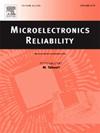Investigation of DFF cells SEU effect for 14 nm bulk silicon FinFET technology irradiated by heavy ions
IF 1.9
4区 工程技术
Q3 ENGINEERING, ELECTRICAL & ELECTRONIC
引用次数: 0
Abstract
A single-event effect test circuit was implemented in 14 nm bulk silicon FinFET technology, incorporating five flip-flop configurations: a standard D-type flip-flop (DFF), a logic depth DFF (LOG-DFF), a compact triple modular redundancy DFF (TMR-DFF), an interleaved TMR-DFF (INTER-TMR-DFF), and a dual interlocked storage cell DFF (DICE-DFF). Radiation testing was performed using heavy ion accelerator facilities with four ion species (F, Cl, Ge, and Ta). Experimental results demonstrated that the INTER-TMR-DFF achieved optimal single-event upset (SEU) resistance, although with area overhead, higher propagation delay, and greater power consumption compared to the baseline DFF. Both TMR-DFF and DICE-DFF exhibited effective radiation hardening at low linear energy transfer (LET) values, but showed degraded performance at higher LET levels. Notably, the DICE-DFF displayed a 40.7% increase in saturation cross-section relative to the standard DFF at LET values equal to 83.8 MeV·cm2/mg. This performance degradation under high-LET conditions correlates with technology scaling effects in advanced nanoscale processes: reduced feature sizes and increased transistor density exacerbate charge sharing phenomena. These parasitic charge redistribution effects fundamentally influence SEU mechanisms, compromising the radiation hardening benefits of both TMR-DFF and DICE-DFF architectures. Comprehensive comparative analysis evaluated all five flip-flop designs across multiple metrics: area occupation, propagation delay, power consumption, transistor count, and SEU resistance performance.
重离子辐照14nm块体硅FinFET技术DFF电池SEU效应研究
采用14nm体硅FinFET技术实现了单事件效应测试电路,包含五种触发器配置:标准d型触发器(DFF)、逻辑深度触发器(LOG-DFF)、紧凑型三模冗余触发器(TMR-DFF)、交错TMR-DFF (INTER-TMR-DFF)和双联锁存储单元DFF (DICE-DFF)。使用重离子加速器设备进行辐射测试,其中有四种离子(F、Cl、Ge和Ta)。实验结果表明,尽管与基线DFF相比,INTER-TMR-DFF具有面积开销、更高的传播延迟和更大的功耗,但具有最佳的单事件干扰(SEU)抗性。TMR-DFF和DICE-DFF在较低的线性能量传递(LET)值下均表现出有效的辐射硬化,但在较高的LET水平下表现出性能下降。值得注意的是,当LET值为83.8 MeV·cm2/mg时,与标准DFF相比,DICE-DFF的饱和截面增加了40.7%。在高let条件下,这种性能下降与先进纳米级工艺中的技术缩放效应有关:减小的特征尺寸和增加的晶体管密度加剧了电荷共享现象。这些寄生电荷再分配效应从根本上影响了SEU机制,损害了TMR-DFF和DICE-DFF结构的辐射硬化效果。综合比较分析评估了所有五种触发器设计的多个指标:面积占用、传播延迟、功耗、晶体管数量和SEU电阻性能。
本文章由计算机程序翻译,如有差异,请以英文原文为准。
求助全文
约1分钟内获得全文
求助全文
来源期刊

Microelectronics Reliability
工程技术-工程:电子与电气
CiteScore
3.30
自引率
12.50%
发文量
342
审稿时长
68 days
期刊介绍:
Microelectronics Reliability, is dedicated to disseminating the latest research results and related information on the reliability of microelectronic devices, circuits and systems, from materials, process and manufacturing, to design, testing and operation. The coverage of the journal includes the following topics: measurement, understanding and analysis; evaluation and prediction; modelling and simulation; methodologies and mitigation. Papers which combine reliability with other important areas of microelectronics engineering, such as design, fabrication, integration, testing, and field operation will also be welcome, and practical papers reporting case studies in the field and specific application domains are particularly encouraged.
Most accepted papers will be published as Research Papers, describing significant advances and completed work. Papers reviewing important developing topics of general interest may be accepted for publication as Review Papers. Urgent communications of a more preliminary nature and short reports on completed practical work of current interest may be considered for publication as Research Notes. All contributions are subject to peer review by leading experts in the field.
 求助内容:
求助内容: 应助结果提醒方式:
应助结果提醒方式:


